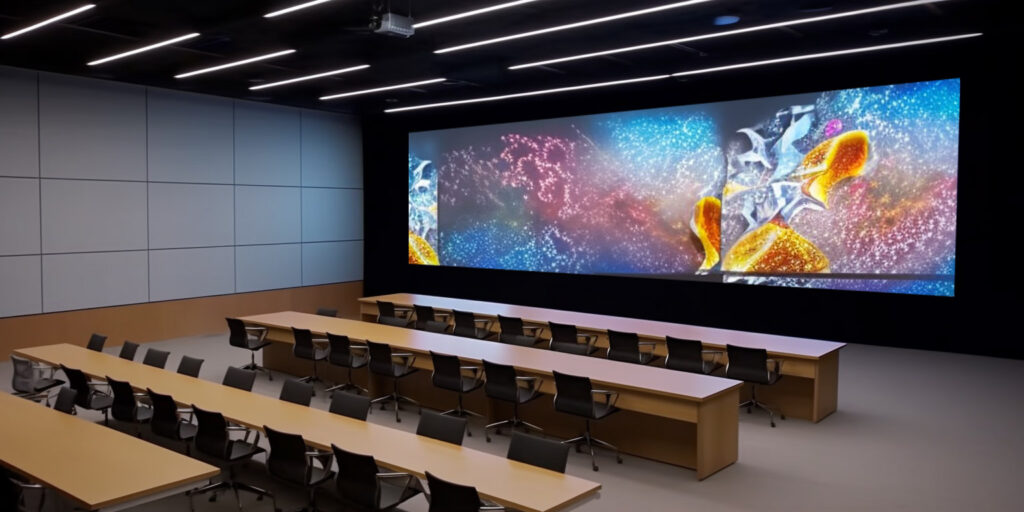In today’s digital age, the education sector is continually evolving. However, many institutions still rely on outdated systems such as small screens, low-resolution projectors, and old-fashioned technology, which hinder the effective transfer of knowledge. To address these challenges, universities, campuses, and educational centers worldwide are turning to a revolutionary solution: LED technology. With unparalleled visual clarity, vibrant colors, and impressive sizes, LED video walls for libraries transform classrooms into immersive learning environments.
The global market for educational smart panels is valued at $3.2 billion in 2024 and is projected to grow by 5.7% annually through 2034 (GM Insights). This substantial investment highlights the increasing recognition that modern technology is crucial for the future of education. In this article, we’ll explore the best LED displays available for every environment, from small classrooms to large auditoriums, and examine how these devices are reshaping teaching and learning for the 21st century.
How LED Technology is Changing the Landscape of Universities
Higher education is at a crossroads, where technology is not just a complement but a transformative force in the learning experience. At the forefront of this transformation are LED screen panels, which are revolutionizing campus environments. This section delves into how LED technology enhances student engagement, fosters collaboration, and creates dynamic, stimulating educational spaces.
Elevating the Student Experience
Classrooms are no longer confined to traditional teaching tools like books and whiteboards. Today’s students expect more: immersive, engaging content that connects them to their studies and sparks their curiosity. LED tech delivers this by bringing complex visuals and videos to life.
Industry leader Novastar sets the standard with cutting-edge video processing solutions, ensuring that LED displays reach their full potential. These high-definition screens transform ordinary lessons into captivating, interactive experiences that resonate with today’s tech-savvy students.
Modernizing Traditional Classrooms
For universities and educational institutions, staying up to date is vital to providing a top-tier education. Modern technology not only boosts competitiveness in rankings but also opens doors to investment opportunities and grants. LED module panels replace outdated projectors, enabling digital signage, live-streamed lectures, collaborative spaces, and much more.
Crucial Features to Look for in an LED Screen for Lecture Halls
Choosing the right LED screen is a strategic decision. With so many options available, it’s essential to prioritize key features that ensure performance and long-term value. Below, we’ll break down the most important factors for educational institutions, from resolution and brightness to ease of installation and maintenance.
Visual Clarity for Every Seat in the Room
Whether sitting in the front row or the back, students need to follow the lecture with ease. Pixel pitch and resolution are essential for achieving this. Pixel pitch refers to the distance between adjacent pixels on the screen. A smaller pitch means closer pixels, resulting in sharper, more detailed images, ideal for close viewing distances.
Resolution, on the other hand, refers to the total number of pixels that make up the display. Higher resolution means more pixels, which contribute to a clearer, more vibrant picture.
Flexibility in Setup and Usage
Lecture halls vary in size and function. Some are designed for large conferences, while others are meant for smaller seminars or collaborative workshops. LED displays offer flexibility in installation, with options for wall-mounted, ground-supported, or flown setups:
Wall-mounted
Best for permanent installations where space is at a premium.
Ground-supported
Ideal for temporary setups that require portability and ease of adjustment.
Flown
Perfect for large spaces like auditoriums or conference rooms where visibility is paramount. Its lightweight design simplifies installation and reconfiguration.
A Long-Term Investment for Academic Institutions
LED walls offer more than just immediate visual appeal; they represent a long-term investment. This section explores the durability, energy efficiency, and adaptability of LED technology, emphasizing its value for educational environments.
Ruggedness for All Environments
LED screens come with varying levels of protection. IP45 and IP65 ratings indicate their durability:
IP45: Protected against solids larger than 1 mm and water jets from any direction.
IP65: Fully protected against dust and low-pressure water jets from any angle.
Whether in high-traffic auditoriums or humidity-prone classrooms, these ratings ensure the reliability and longevity of LED screens.
Simplifying Repairs and Maintenance
LED displays with full front-facing service capabilities make maintenance easier by allowing technicians to access all components from the front. Magnetic modules also simplify repairs by enabling quick part replacements without interrupting classes or events, minimizing disruptions.
Making the Right Choice for Your Teaching Spaces
This article offers a practical guide for academic institutions looking to create interactive, dynamic, and student-centered learning environments through the best LED technology.
Understanding Value and ROI
Although LED solutions come with a higher initial cost than traditional projectors, their long-term benefits make them a wise investment. The durability, lower maintenance costs, and superior image quality result in substantial returns over time, both in terms of savings and improved student engagement. Companies like Mirackle, backs its LED video walls with a three-year warranty, providing peace of mind.
Furthermore, the U.S. government is offering incentives to promote technology upgrades in education.
The Future of Learning Spaces
LED technology’s versatility in adapting to various teaching styles, improving student outcomes, and seamlessly integrating with other tech systems makes it an essential component of modern educational environments. Beyond classrooms, LED display panels are used in gymnasiums, auditoriums, wayfinding systems, and research centers to display everything from sports scores to complex data.


